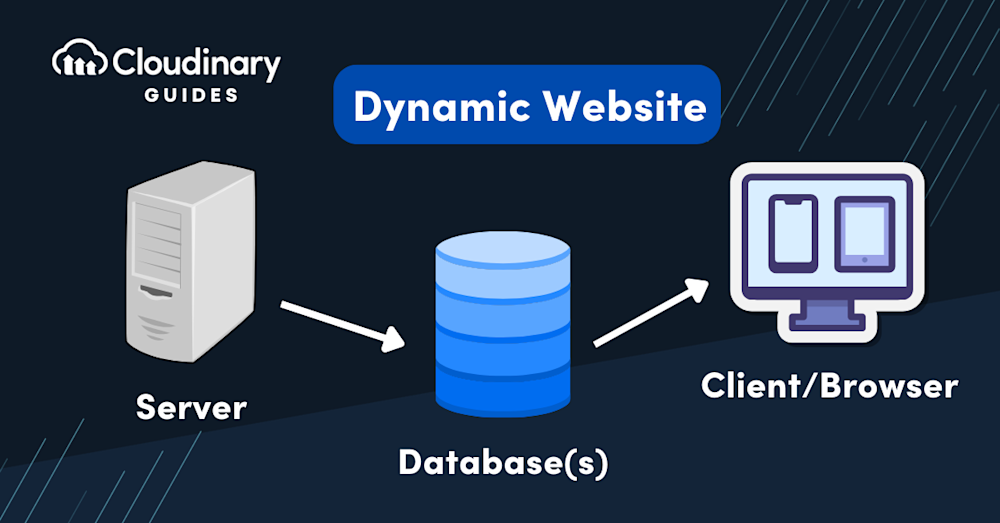Definition of DYNAMIC WEBSITE DEVELOPMENT
A dynamic website is one that changes the type of material that is displayed each time a person accesses it. This display varies depending on the viewer’s demographics, the time of day, the location, language preferences, and other elements.
Dynamic websites provide unique content to viewers each time they visit the site, in contrast to static pages, whose contents must be manually updated before they change. Information that changes depending on the user, the time of day, the local time, the user’s native language, as well as other characteristics can be found on a web application or dynamic web page. For instance, the main page of Computer Hope is a dynamic website that dynamically updates each day to provide users with fresh content. However, the page you’re viewing right now is static, meaning it won’t change until it is updated.
A combo of client-side and server scripting is used to accomplish this.
- Using programming languages like JavaScript, client-side scripting entails writing code that is run by the viewer’s browser. This scripting is in charge of making adjustments to the homepage in response to user input, such as mouse or keyboard clicks.
- On the other hand, server-side scripting relates to code that is run by the website before the material is sent to the viewer’s browser. When a web page is loaded or accessed, such as with a login screen, registration forms, and shopping carts, this has an impact.
Modern websites may adjust to each user’s perspective of the page and take less time to load by using both kinds of scripting. Additionally, these scripts are more secure, thus when you perform network penetration testing, you might detect no or very few flaws in the network.
How it works
- Real-time content is displayed on dynamic websites. JavaScript, therefore, checks the host for the requested contents when the user requests to display the content.
- Either checking its URL or addressing the user directly is used to do this. Now, JavaScript is used to send a request for the relevant data to the server.
- The server’s data is checked using a PHP script. The information between JavaScript and PHP is used to produce a command in SQL after this script has been sent through it.
- The database will not recognize straight coding or any scripts, this SQL query is used to retrieve data from the database. Now, the PHP script receives the data that SQL has just fetched.
- In order for JavaScript to interpret the output, the data that is being received must be converted. The PHP script is being used to perform this conversion. Because JavaScript is unable to access SQL data, Java Script Object Designation steps in to save the day.
Features of dynamic website
-
Management of pages
Users can manage their websites however they like with the capabilities provided by webpage management or content software solutions. They provide templates and forms that make it simple to add and update information on the website.
-
Guestbook
A guestbook often called a visit log, is a physical or digital mechanism for visitors to recognize their presence and can be kept offline or online. Typically, one leaves any comments, their name, postal address, and any necessary notes.
-
Search Tools
It is the most crucial element for a website since it facilitates website exploration. Additionally, end-users won’t be concerned about the length of your website because they’ll be eager to use it. Search engines are one of the most common technologies utilized by consumers.
-
Management of users
User management, which discusses how you may safeguard your server with the assistance of employing straightforward and efficient user account management procedures, is one of the most important aspects of establishing a safe system.
-
Header Banner Control:
This enables comprehensive administration of clickstream tracking and banner ad presentation. Banners can be kept on your server, the interchange host server, or a distant server using the GIF banner image file’s URL (uniform resource locator).
-
Managing Multimedia Files:
Whenever you need to, you can utilize Inigo’s constructed multimedia manager to add new multimedia files to your website. Additionally, you can include unique filters that let you automatically alter photographs to match the requirements of the website.
Benefits of dynamic website
-
Easier to keep up
A content management solution (CMS), which offers a database for content as well as other page elements, is used by dynamic websites. Additionally, these websites employ scripting languages that communicate with the data stored in the database, making it simpler to implement site-wide updates without having to do it one at a time.
-
Better individualized browsing
Giving consumers a customized browsing experience while they are on your website is one of the main advantages of having a dynamic website. Offering material based on region and demographics, features for recently seen things, content and product ideas, and even content suggestions may all be used to encourage people to stay on your website and possibly take another step with your company.
-
Increased user satisfaction
Dynamic web pages allow additional features in addition to customizing each visitor’s web browsing experience. Dynamic websites make it possible to modify the site to better suit user needs and provide a more user-friendly navigation system. A dynamic website also makes it simple to upgrade and add new features, which is helpful for enhancing the user experience.
-
Enhanced professional appearance
Professional static sites are conceivable, but they lack the functions and other components that many people demand from a contemporary website. Dynamic websites not only offer the features and interaction that visitors desire, but the simplicity of modification that goes along with them also elevates the professional appearance.
-
Professional-looking
Compared to static websites, dynamic websites provide you with a more polished appearance. This is typically due to the lack of numerous features and components that customers have come to anticipate from contemporary websites. Dynamic websites can look much more professional thanks to functionality, interaction, and ease of editing.
-
Futuristic
Dynamic websites enable the user to interact & participate more with the site’s content. They elevate individuals through individualized browsing by providing them with an interactive and dynamic experience. Compared to static blocks of letters and images, an experience that has an impact is more likely to last with someone for a long time.
Negative aspects of dynamic websites
- These websites are complicated.
- The cost of developing these is higher.
- These websites’ hosting fees are also higher.
- It needs a quick, powerful web server.
Conclusion
A dynamic website, you can quickly and easily update the information on your page, fix any errors, and incorporate any new goods or services. By doing this, you can ensure that your website always has updated content that will entice visitors to return for more. A dynamic website allows you to control your content using an administrative interface. Dynamic websites provide you with total control over the server and allow you to update it yourself without having to rely on a website development company. The majority of the websites that Think N Code creates are dynamic.
Frequently Asked Question
Websites that are constructed using a computer language to change content are known as dynamic websites. They enable you to change the content your website offers, which is frequently quite helpful if you sell a variety of goods or services over the course of the year.
Developing a website that will appeal to and convert your intended audience is one of the most important things you can take to expand your business.
When a user requests a dynamic page, the webserver does not immediately send the page to the requesting browser as would with a request for a static page.
Information derived from:




